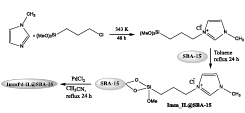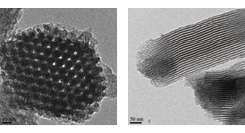Development of Metal Ion-Containing Ionic Liquid Catalyst on Mesoporous Silica
T. Sasaki
We have been developing and using metal ion-containing immobilized ionic liquid catalysts in order to design heterogeneous catalysts by utilizing the characteristics of ionic liquids, where ionic liquid molecule with imidazolium cation moiety is immobilized on silica support and the metal halogenate anions are introduced as counter anion serving as reaction centers [1, 2]. It was found that the ImmCu_IL containing [CuCl4]2- is active for Kharasch addition reaction between styrene and CCl4. ImmNi_IL was found to be active for Suzuki cross coupling reactions with chlroarenes and phenyl boronic acids. ImmPd_IL was found to be active in a phosphine-free condition for Suzuki cross coupling reaction for bromoarenes [2].

Scheme 1. Synthetic steps for the ImmPd-IL@SBA-15 catalyst.

Fig. 1. TEM images of fresh ImmPd-IL@SBA15
We report the synthesis and application of immobilized palladium metal-containing ionic liquid supported on mesoporous silica such as SBA-15 (ImmPd-IL@SBA-15) as a novel catalyst for organic reactions. There are several advantages by using mesoporous material such as SBA-15 as a support. It has high surface area, easy to prepare, high gas adsorption capacity and high temperature tolerance.
The synthesis procedures were adopted from our method [1, 2] and all the reactions were conducted under nitrogen atmosphere (Scheme 1). Immobilized ionic liquid on SBA-15 samples were prepared using 1-methyl-3-(3-trimethoxysilylpropyl) imidazolium chloride (Mtim chloride). Mtim chloride was synthesized by refluxing the mixture of N-methylimidazole and 3-trimethoxysilylpropyl chloride at 70°C for 48 h. Mtim chloride and SBA-15 were dispersed in dehydrate toluene and refluxing, yielding solid products, Imm-IL@SBA-15. PdCl2 and solid product were added to acetonitrile solution. After refluxing for 24 h, the resulting materials are obtained, denoted as ImmPd-IL@SBA-15. Fig. 1 shows TEM images for fresh ImmPd-IL@SBA15. Transmission Electron Microscope (JEOL JEM-2100 in ISSP, Univ. Tokyo) operating at 200 kV was used to obtain bright field images. It is found that uniform hexagonal channel structures are retained after immobilization of imidazolium groups. No Pd nanoparticles are found. The presence of [PdCl4]2- was also confirmed by EDX analysis and EXAFS measurements.
It was found that the ImmPd-IL@SBA-15 catalyst has significantly improved the catalytic activity for synthesis of urea and oxamate derivatives by oxidative carbonylation of amines under co-catalyst, dehydrating agent and ligand free conditions [3]. ImmPd-IL@SBA-15 was also found to catalyze polyester amide synthesis by carbonylation polycondensation [4].
References
- [1] T. Sasaki, C. Zhong, M. Tada, and Y. Iwasawa, Chem. Commun., 2506 (2005).
- [2] T. Sasaki, M.Tada, C. Zhong, T. Kume, and Y. Iwasawa, J. Mol. Catal. A-Chem. 279, 200 (2008).
- [3] S. T. Gadge, E. N. Kusumawati, K. Harada, T. Sasaki, D. Nishio- Hamane, and B. M. Bhanage, J. Mol. Catal. A Chemical 400, 170 (2015).
- [4] A. Satapathy, S. T. Gadge, E. N. Kusumawati, K. Harada, T. Sasaki, D. Nishio-Hamane, and B. M. Bhanage, Catal. Lett. 145, 824 (2015).
